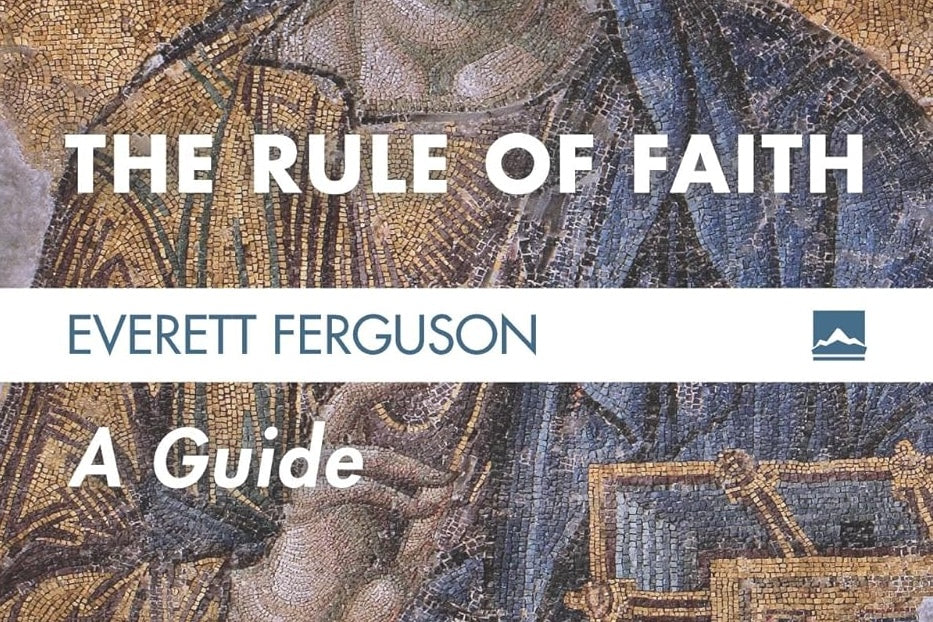In The Rule of Faith, Everett Ferguson discusses the historical utility of the “rule of faith” and proposes its continuing relevance. The rule, which Ferguson distinguishes from creeds because it does not require adherence to anything outside of Scripture or beyond the apostles’ teaching, is a synthesis and reminder of core Christian doctrines without philosophical or advanced theological explanations. In his estimation, most churches—and especially non-creedal churches—would benefit from synthesized statements of core doctrine like those used in the early church. These summaries of apostolic preaching would help in, among other ways, addressing visitors, instructing new members, clarifying core beliefs for believers seeking to identify with them, and assessing the credibility of new ideas.
For Ferguson, the existence of such a standard is a logical necessity. While people use the label “Christian” with reference to disparate and sometimes conflicting propositions, there is an objective core of authentic Christianity that particular beliefs—and presumably those holding the beliefs—either align with or do not. This does not intimate that Christians do or must agree on every matter of Christian doctrine, but it does mean there is a critical core of beliefs that a person cannot fairly be identified as Christian without embracing. This core is distinct from the baptismal confession in function and from creeds in content. The rule and the confession are complementary and had parallel developments, but creeds emphasize extra-biblical distinctives for particular religious groups that might ostensibly be fairly characterized as Christian.
In order to demonstrate the merits of his argument, Ferguson surveys primary sources to show that the rule of faith has an ancient heritage among believers. While early Christian authors spoke of the rule in varied ways—e.g., the “rule of faith,” the “canon of faith,” and “truth”—the concept appears early and consistently beginning with the writings of men like Justin Martyr and Irenaeus in the second century. Although there was no fixed name or formulation in second or third centuries for what is now called the rule of faith, there was a definite substance: the preaching and teaching content of the church derived from Christ, handed down by the apostles, and focused on the career of Jesus—especially his death, burial, and resurrection—in the larger context of faith in God and the church’s experience of the Holy Spirit. This Christ-centered, trinitarian core is the historical standard for Christian identity.
After briefly surveying the historicity of the concept, Ferguson observes that some recent studies incorrectly conflate the rule of faith with the confession of faith. These studies misunderstand the relationship between the rule and the confession. The two are similar in content but functionally distinct. Whereas the rule of faith summarized the objective teaching content of the church, the baptismal confession was the subjective acceptance of the content which have been taught. The rule was used in making disciples, refuting heresy, and guiding the interpretation of Scripture. While expression of the rule remained fluid, the confession ultimately became fixed and formulaic.
Ferguson’s argument is brief and effective in that he demonstrates the ancient vintage of the rule of faith and its practical deployment in the Christian church while distinguishing it from the confession of faith and especially creeds with their fixed forms. It is beyond credible dispute that early Christianity included a unique core of teaching content and that those who embraced this core were distinct from those who did not. These two premises are important and relevant in today’s relativistic climate where terms are sometimes reimagined and bandied about without regard to their historical and objective denotations.
Ferguson is correct that the rule of faith still has utility for making disciples, addressing heretical doctrines, and guiding the interpretation of Scripture. Even non-creedal churches are aware of the rule and use it—sometimes more intuitively than intentionally—in the ways Ferguson proffers. They use it, perhaps in concert with creeds and other things, on their websites and advertisements. They also use it when determining doctrines that will and will not be tolerated.
To the extent Ferguson hopes broad recognition of the rule of faith—in basic content rather than fixed form—will foster unity among churches, the potential is notable but limited. The rule is specific enough to rule out the most marginal views of what it means to be Christian, but it is so broad that substantial issues remain. Still, broad recognition of the general core and a spirit of mutual identification centered around the core offers a platform upon which those seeking to be authentically Christian can and should engage and ultimately coalesce in making disciples and interpreting Scripture.

